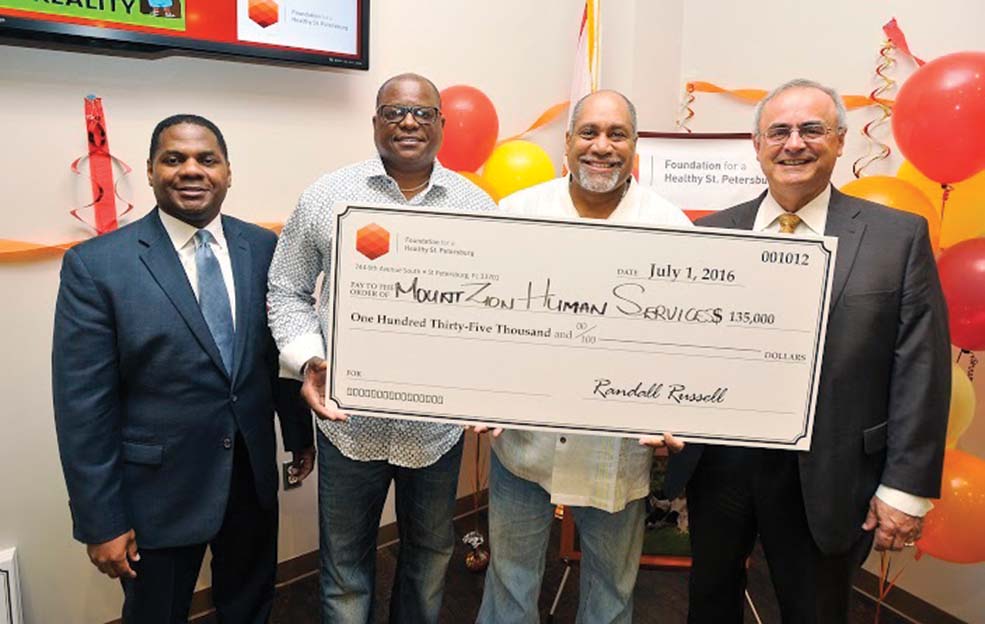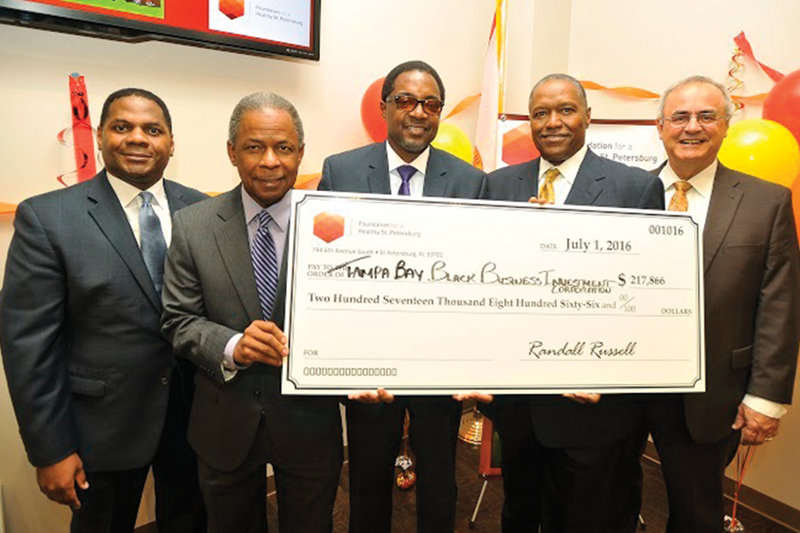L-R, Curtis Hollomon, Ron Peterson, Albert Lee, Monte Trammer and Steve Dupré
BY GYPSY C. GALLARDO, Contributor
ST. PETERSBURG – At long last, the foundation created by the sale of Bayfront Medical Center in April 2013 made its first round of grants this June, totaling $3.9 million to 19 community-based organizations. From all appearances, the charitable vehicle – now called the Foundation for a Healthy St. Pete – is bent on breaking the mold.
Some in the community thought the foundation – originally called Bayfront HERO, which stood for Health Education and Research Organization, – was a flash in the pan that would quickly fade once Bayfront was unexpectedly sold for a second time in late 2013.
Not so, however, since its original architects saw to it that the foundation would be a permanent facet of Bayfront’s future – no matter who owns the facility. The foundation is supported by a $170 million endowment, the income from which will be invested in perpetuity into the future of the community.
City of St. Petersburg Deputy Mayor Dr. Kanika Tomalin helped lead the foundation’s creation in her former role as a Vice President with Bayfront.
“Social equity in health and wellness is an integral element of our community’s collective work to eradicate poverty and the funding provided by the Foundation is transformational toward that end,” she said.
“New school” approach to investing
Rather than seeding dollars into traditional “health” initiatives, the foundation is strategically spreading its wings to focus on improving the many “social determinants of health,” i.e., the life circumstances that contribute to people’s health status, such as employment, income and education gaps.

L-R, Curtis Hollomon, Rev. Louis Murphy, Carl Lavender and Steve Dupré
And rather than taking the usual route to grant-making decisions, the foundation is trying out what appears to be an unprecedented focus – at least locally — on “social justice.”
In a June 23 editorial for the Tampa Bay Times, Foundation CEO Randy Russell wrote; “The Foundation is about social justice at its core. The fair and equitable distribution of wealth, opportunity and privilege within a society or population is one of the foundation’s primary areas of focus. Privilege comes by birth; as does stigma. Gender, color, class, ability and nurturing create degrees of privilege…Privilege both impels and impedes opportunity…One thing is certain: Groups of people who are stigmatized or ignored (perhaps worse), who lack all of the concomitants of social justice, are less healthy. For us to achieve any substantial improvements in population health, we must direct our work, and discipline our efforts, to the linchpin of social justice.”
Through that lens, the foundation’s inaugural round of grants seems to be aimed at leveling the economic and social playing field for some of society’s most vulnerable population groups, such as the mentally ill and victims of domestic violence.
The new paradigm for giving is also channeling resources into groups with the greatest potential for positive gains, such as helping low-income entrepreneurs bring their business concepts to fruition and helping ex-offenders to break into an often unwelcoming job market.
On this score, Dr. Tomalin said: “The Foundation is not only funding efforts that combat the existing challenges of our healthcare landscape, but strategically attacking the social determinants of those conditions. We are fortunate to count them as partners and grateful for the difference all those who have been funded will make.”
Among the first harvest of grant recipients:
• Pinellas Ex-Offender Re-Entry Coalition (PERC) – The PERC Hires T.A.M.E. (Treatment for Addiction + Mentoring = Employment) Program, a job centered initiative, will use cutting edge technology combined with face to face employment development and mentoring to help transition those in treatment centers and community release centers in St. Petersburg to follow a path to recovery and better health. The PERC project will measure the usage of Second Chance Kiosks at residential and community release centers, to search and to obtain employment opportunities.
• Community Action Stops Abuse (CASA) – CASA will focus its efforts on the social and economic factors that impact population health. The goal of their proposed project is to conduct an assessment of program participant training and employment needs; to conduct market research to determine the feasibility and viability of a social enterprise, and to develop a business plan for a sustainable social enterprise. Three potential social entrepreneur businesses/ services addressing CASA’s priorities of helping domestic violence victims gain employability skills while building a new revenue stream to support CASA services will be identified during this project.
• The Tampa Bay Black Business Investment Corporation (BBIC) – BBIC will intensively support 20 primarily low-income entrepreneurs to launch or grow their firms – creating employment for themselves and others – via the CATCH Program, which will provide them training, coaching, consulting and access to capital, beginning with micro business stipends to fuel their near-term business plans. This project will impact the social and economic factors that impact population health to include employment.
• The St. Petersburg Area Chamber of Commerce – A new Community Business Development Initiative (CBDI) will impact the social and economic factors impacting population health by creating a pilot program that provides specialized training, mentorship, technical assistance, and small business grants to the citizens of South St. Petersburg, giving them skills and resources necessary to start their own business or maximize current business revenue potential. The project will produce businesses that are better able to stand the test of time, with 80% of participants still in business by 2020 and the majority of businesses (60%) successful enough to create at least five new jobs over the course of that time. The long-term goal of this project is an overall reduction of poverty in South St. Petersburg.
To view the complete list of 19 grantees, visit the Foundation website, click on Grant-Making and then click “Inaugural 2016 Funded Partners” (www.healthystpete.foundation).
What’s next for the Foundation?
Foundation leaders stress that grant making is only one part of their vision for “transformational change” in southern Pinellas County (the Foundation’s service area) – an admittedly lofty goal that Russell said “requires a multisector, multifaceted, co-created approach.”
He and the nine-member board of trustees are guiding the charity to invest in three other areas that they consider equally important: policy and advocacy to impact change on a systemic level; convening people and organizations to work together more collaboratively and media and strategic communications to educate the local community and decision-makers on issues impacting population health.
Quick Facts about the Foundation
• Founded: 2013
• Estimated Annual Giving: This will depend on earnings of a permanent endowment now worth $170 million)
• Service Area: South Pinellas County (south of Ulmerton Road)
• Next Grant-Making Round: In 2017, date to be determined
• How to Connect/Learn more:
• CEO Randall H. Russell
• Tel – 727-865-4650
Post Views:
20,403
